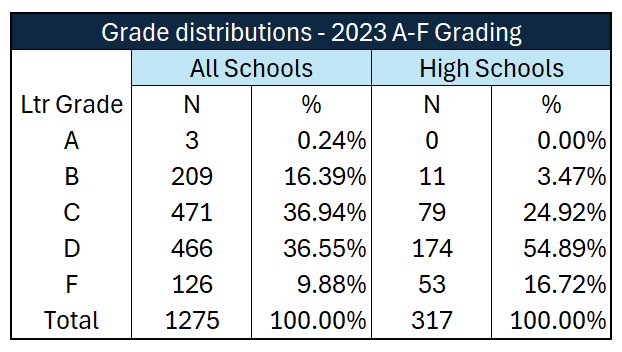The 2023 A-F grading of Kansas public and private schools is now available online. (A printed form is forthcoming. E-mail [email protected]. to request a copy.)
The public education landscape continues to change, with more parents opting for alternatives to sending their children to traditional public schools. This phenomenon was exacerbated by unwarranted school closures as a response to COVID-19. People are hungry for a change, especially those who feel stuck in underperforming schools. But the question is, where does one go to find out how a school in the state is actually performing?
Welcome to Kansas Policy Institute’s A-F Grading. A-F Grading is a ‘one-stop’ destination to find out how many of Kansas’s roughly 1,300 public and many private schools are faring in a simple to understand format. This is something you cannot get through KSDE. Despite the fact that the Feds prescribe KSDE to publish a ‘report card’, the factors that make up that report card are scattered about KSDE’s website. More importantly, there is no letter grading system that provides a summary of any particular school. KPI has taken the initiative to letter-grade schools. And it’s all right here.
The A-F Grading system is also important because it reveals the real state of performance of Kansas schools. While the State Board of Education and KSDE lead us to believe that “Kansas leads the world in the success of each student,” this KPI presentation and analysis of state-produced data tells a much different story regarding student achievement. In a world that is increasingly distrustful of bureaucratic government information (and rightfully so), it is essential to have independent voices like KPI’s to monitor and document realities. A-F Grading continues to be one such repository.
The 2023 edition includes grades for 1,275 total public and private schools, based on the most recently available state assessments.
A total of 1,275 public and private schools received grades for 2023 based on the schools that take the state assessment: a few schools that do take the exam had to be excluded because of data limitations and privacy concerns. The distribution is reflected in the adjacent table. Only three schools received an overall grade of “A” – all three are elementary schools. Two are public schools, Timber Creek Elementary School and Mission Trail Elementary School, both in the Blue Valley (USD 229) district. The other school that earned an “A” is St. Patrick Catholic Elementary School in Parsons. Roughly one in six elementary schools received a “B.”

High schools in Kansas continue to struggle. No high schools received an overall grade of “A”, while 11 earned a “B.” More than half of all high schools earned a “D.” Overall, the grades changed little from 2022. The biggest difference is that in 2023 the percentage of schools earning a grade of “F” nearly doubled.
This grading system began in 2017 and has been produced annually, save 2020 when Governor Kelly shut down the schools during the pandemic and tests where not taken. The purpose of the A-F grading system is to give parents an easy-to-understand “one-stop-shopping” system of how schools are actually performing. The Kansas State Department of Education (KSDE) publishes a “Report Card” on its website, but one must navigate through a myriad of indicators, and there is no grade-based summary for each school. KSDE employs such benign terms as “limited”, “basic”, “effective”, and “excellent” to describe a student’s state assessment scores. But what does that really mean?
KPI takes those state assessment results reported by KSDE and translates raw scores (which range from 220 to 380 for math and for English language arts – ELA) into letter grades. (A full methodology outline, data, and definitions is available on the A-F Grading home page.) This process gives a more concrete explanation of those results.
A-F grading on the website contains an abundance of data in addition to a school’s overall letter grade. Included are: a pin mapping system that shows the location of each school, contact information, enrollment, per-pupil spending, grade-level grades for both low-income and other students, % of low-income students and proficiency rates for both math and English language arts (ELA).
This reporting system continues to provide opportunities to explore questions surrounding the issue of school performance. Why do some schools continue to out-perform others? Why does the education establishment continue to lobby for more money when it is clear from this data that spending and school performance are not related?
.





